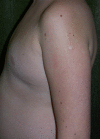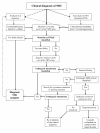Nijmegen breakage syndrome (NBS)
- PMID: 22373003
- PMCID: PMC3314554
- DOI: 10.1186/1750-1172-7-13
Nijmegen breakage syndrome (NBS)
Abstract
Nijmegen breakage syndrome (NBS) is a rare autosomal recessive syndrome of chromosomal instability mainly characterized by microcephaly at birth, combined immunodeficiency and predisposition to malignancies. Due to a founder mutation in the underlying NBN gene (c.657_661del5) the disease is encountered most frequently among Slavic populations. The principal clinical manifestations of the syndrome are: microcephaly, present at birth and progressive with age, dysmorphic facial features, mild growth retardation, mild-to-moderate intellectual disability, and, in females, hypergonadotropic hypogonadism. Combined cellular and humoral immunodeficiency with recurrent sinopulmonary infections, a strong predisposition to develop malignancies (predominantly of lymphoid origin) and radiosensitivity are other integral manifestations of the syndrome. The NBN gene codes for nibrin which, as part of a DNA repair complex, plays a critical nuclear role wherever double-stranded DNA ends occur, either physiologically or as a result of mutagenic exposure. Laboratory findings include: (1) spontaneous chromosomal breakage in peripheral T lymphocytes with rearrangements preferentially involving chromosomes 7 and 14, (2) sensitivity to ionizing radiation or radiomimetics as demonstrated in vitro by cytogenetic methods or by colony survival assay, (3) radioresistant DNA synthesis, (4) biallelic hypomorphic mutations in the NBN gene, and (5) absence of full-length nibrin protein. Microcephaly and immunodeficiency are common to DNA ligase IV deficiency (LIG4 syndrome) and severe combined immunodeficiency with microcephaly, growth retardation, and sensitivity to ionizing radiation due to NHEJ1 deficiency (NHEJ1 syndrome). In fact, NBS was most commonly confused with Fanconi anaemia and LIG4 syndrome. Genetic counselling should inform parents of an affected child of the 25% risk for further children to be affected. Prenatal molecular genetic diagnosis is possible if disease-causing mutations in both alleles of the NBN gene are known. No specific therapy is available for NBS, however, hematopoietic stem cell transplantation may be one option for some patients. Prognosis is generally poor due to the extremely high rate of malignancies.
Figures





References
-
- Hustinx TW, Scheres JM, Weemaes CM, ter Haar BG, Janssen AH. Karyotype instability with multiple 7/14 and 7/7 rearrangements. Hum Genet. 1979;49:199–208. - PubMed
Publication types
MeSH terms
Substances
LinkOut - more resources
Full Text Sources
Research Materials
Miscellaneous

